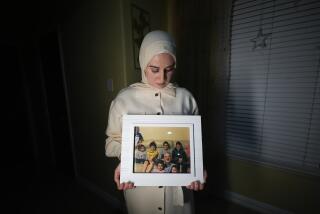Important Iraq Nuclear Facilities Survived, Defector Says : War’s aftermath: Officials are debriefing a scientist who reportedly has asked for U.S. asylum.
- Share via
WASHINGTON — A senior Iraqi nuclear scientist has defected to the United States and told Pentagon experts that a significant part of Saddam Hussein’s nuclear research facilities survived U.S. bombing raids during the Persian Gulf War, officials said Monday.
The defector, who reportedly drove up to a U.S. military checkpoint in northern Iraq last month and asked for asylum, is being debriefed by U.S. officials as part of a wider effort to determine how much nuclear material Iraq still has and whether Hussein’s regime is still capable of developing a nuclear weapon.
The scientist’s account could be vital to a United Nations effort to locate Iraq’s store of weapons-grade uranium and arrange for its destruction.
His reported statements also cast new doubt on the fulfillment of one of the main U.S. aims in the war, the destruction of Iraq’s ability to build weapons of mass destruction.
Gen. H. Norman Schwarzkopf, the allied commander in the war, said in January that U.S.-led bombing raids “have neutralized their manufacturing capabilities, their nuclear manufacturing capability.” The defector’s information reportedly contradicts that claim.
After the war, Iraq initially denied possessing any weapons-grade uranium, the material used in nuclear explosives. Under pressure from the United States and other Western governments, the Baghdad regime later acknowledged that it had 91 pounds of weapons-grade nuclear material. That would be more than enough to build a nuclear bomb, although U.S. experts calculated that Iraq’s research program was at least five years away from building a bomb.
The Defense Department is “taking the lead” in debriefing the scientist, who is being held in protective custody at an undisclosed location, perhaps outside the United States, one official said.
The Bush Administration refused to confirm the defection, which was first reported by National Public Radio.
“I don’t have any comment on the specifics . . . since they clearly involve intelligence matters of some sensitivity,” State Department spokeswoman Margaret Tutwiler said.
Several officials said they are unhappy that the defection had been revealed. “We didn’t want Saddam to know this,” said one. He expressed concern that the Iraqi regime might react by putting its remaining nuclear scientists under close surveillance--thus complicating efforts by U.S. intelligence to contact them.
“None of these cases do we want to deal with in public,” the official said. Asked if his mention of “cases” implies that there is more than one Iraqi defector in U.S. custody, the official refused to speak further.
Tutwiler said that the International Atomic Energy Agency, which sent a team of experts to Iraq in May, probably would carry out “many inspections of Iraq’s nuclear, chemical, biological and missile capabilities in order to ensure their destruction.”
IAEA inspectors toured Iraq in April and May and reported finding about 98 pounds of weapons-grade material, all at the country’s main nuclear research facility at Tuwaitha. Some U.S. officials have said they suspect that smaller amounts of uranium may still be hidden elsewhere in the country.
Iraq has also reported to the United Nations that, at the end of the war, its armed forces still held 11,131 chemical warheads, 1,005 tons of liquid nerve agents, 52 Scud or modified Scud missiles and 28 working Scud launchers--all far more than U.S. officials had estimated.
The scientist told U.S. officials in Iraq that the allies’ 42-day bombing campaign missed some nuclear facilities entirely and failed to destroy others that apparently were targeted but sheltered in deeply buried bunkers, according to the radio report.
More to Read
Sign up for Essential California
The most important California stories and recommendations in your inbox every morning.
You may occasionally receive promotional content from the Los Angeles Times.














